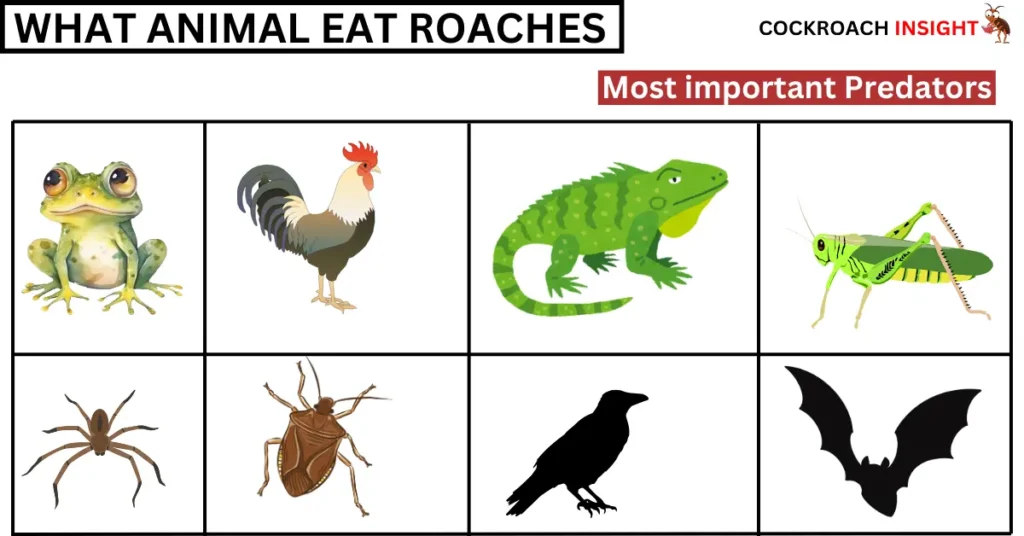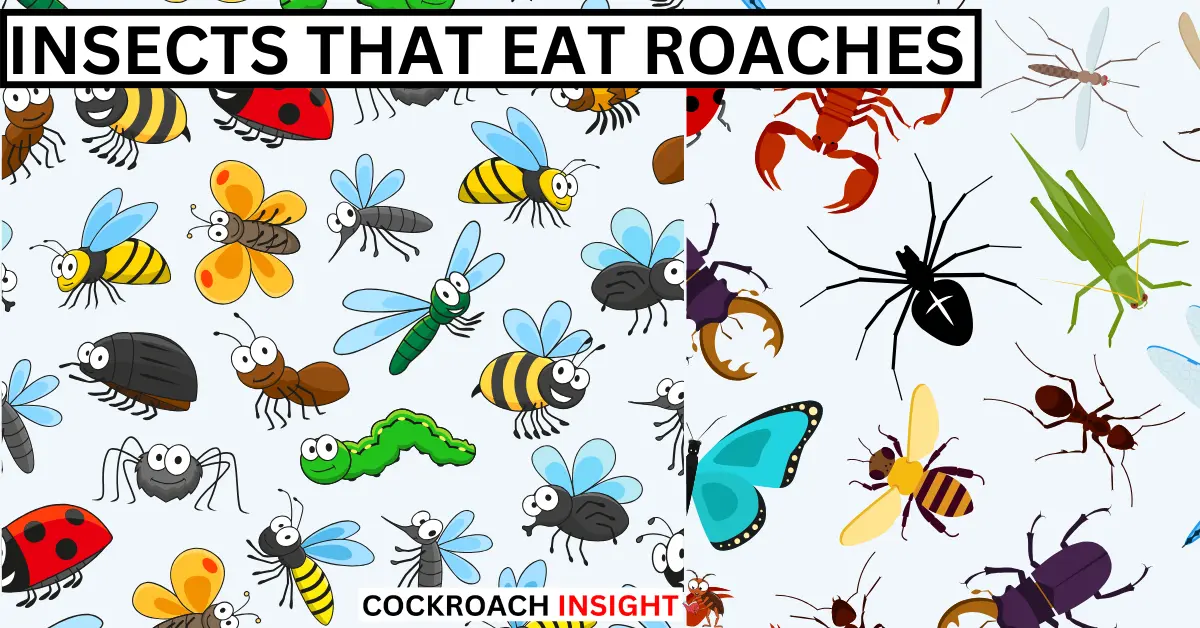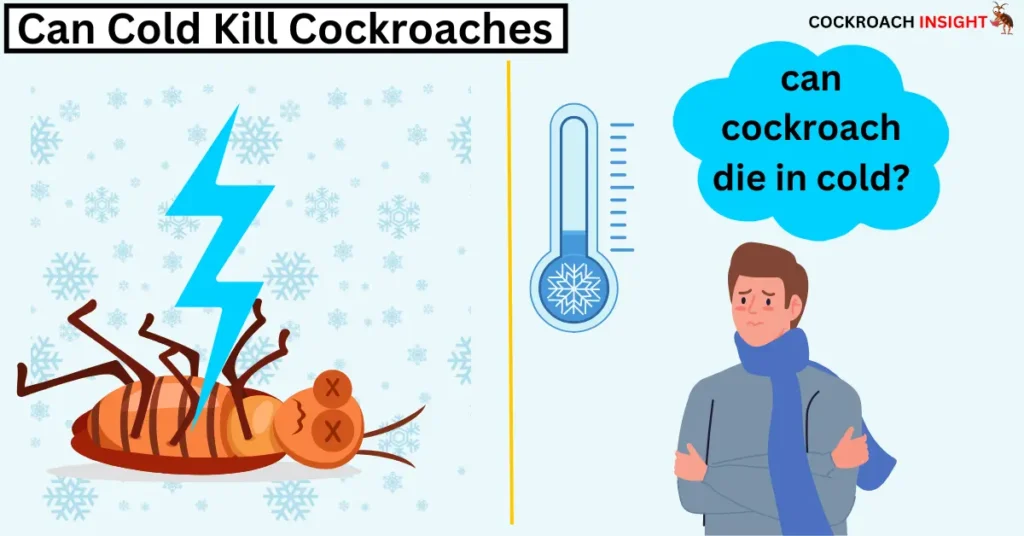Roaches are industrious bugs that live forever because they are challenging to eliminate and are a common pest found in many homes.
While they are primarily a nuisance themselves, they are also a meal for a variety of predators, from insects to larger animals.
Despite this, having natural predators around won’t necessarily help in dealing with a roach infestation, but it is interesting to know what creatures consider them a delicacy.
In fact, there are some pets you can keep that will happily munch on roaches, but they can only eat them in very small numbers, which is useless.
But now you are curious about why we should discuss the natural predators of roaches. If they don’t help, use them to eliminate the infestation. Here are the reasons for examining them.
- It is interesting to know what animals eat roaches.
- Some predators do not harm humans until disturbed, so it is safe to let them in your home.
- Every predator has a unique way of hunting roaches, so it is necessary to know the mechanism of hunting.
- These predators may help you to prevent roaches when they enter your and start to infest your home.
Roaches, despite being industrious bugs and a common meal for many natural predators, are not easily catchable. They have developed a robust defensive system to evade their enemies.
With quick motion and robust speed, they can swiftly escape danger. Their good senses allow them to detect threats early and make them safe.
Additionally, roaches can mimic playing possums to deceive predators. They also use dirt for concealment, making it harder for predators to spot them. These defensive strategies highlight the resilience of roaches in the face of numerous natural threats.
Quick Motion and Fast Speed
 Cockroaches rely on their quick motion and fast speed as their primary defensive mechanism against predators.
Cockroaches rely on their quick motion and fast speed as their primary defensive mechanism against predators.
Except for a few species of cockroaches, almost all roaches can move at a formidable speed, making them elusive targets for determined predators.
American cockroaches are among the fastest than others, reaching speeds of 2.9 to 3 mph. If humans could run as fast as roaches relative to their size, we would reach speeds of 100 mph.
Super Senses
Cockroaches possess extraordinary sensory organs that help them navigate their environment, even in the dark. These super senses, often perceived as telepathic, allow them to know of impending danger.
Their microscopic hairs and antennae on the body surface can detect the slightest movement of air, and their heightened senses anticipate changes in air pressure.
Their senses enables them to identify potential predators and act faster than their attackers. Most of the time, when you try to crush a roach, you will be surprised at how it moves faster than your strike.
Playing Possum
When threatened by predators, cockroaches adopt the tactic of feigning death, known as playing possum. They roll onto their backs to escape larger predators by playing dead, which helps them evade danger as the predator loses interest.
Utilize Dirt for Concealment
Roaches are masters of camouflage and have an innate ability to seek out hiding spots. They use their colour and texture to blend into their surroundings, burrowing into dirt and finding crevices.
This natural concealment serves as a refuge, protecting them from predators and making them inconspicuous. This ability to hide helps them effectively evade predator detection.
Additional Defensive Tactics
In addition to these defenses, some roaches can fly and jump. Roaches usually rely on locomotion, but they can fly and jump when threatened.
The German Cockroach is also good at flying (it is the most common roach in home infestations). Roaches also release a stink when predators come close to them. Large predators also lose interest due to the awful smell.
Natural Predators for Roaches
Roaches, though notorious pests have a variety of natural predators across different animal classes. Here is a detailed look at the natural enemies of roaches :
Insects
They prey on roaches, including ants, wasps, crickets, and beetles.
Arachnids
Such as spiders, tarantulas, and huntsman spiders also hunt roaches.
Reptiles
like lizards, geckos, chameleons, iguanas, and monitor lizards actively hunt and consume roaches.
Amphibians
including frogs and toads, horned frogs, and tree frogs, are known to eat roaches.
Cockroaches are also eaten by mammals like mice, rats, hedgehogs, bats, raccoons, and opossums. Birds such as chickens, ducks, pigeons, crows, and others also eat roaches.
Humans
Some humans also eat roaches due to their nutritional value.
Fungi
Specifically, Beauveria bassiana and Metarhizium anisopliae, which infect and kill roaches.
Among all the categories mentioned above with examples, I included only significant categories with a few examples that are commonly present and that you can quickly identify in everyday routine life.
Insects that eat Roaches
Cockroaches are also insects, but they are the food of many insects. Insects live in similar places and make their nests so they are easily accessible to each other. Now, let’s discuss what insects can eat roaches.
Ants-Do ants eat roaches?
Yes, some species of ants can eat roaches, but it’s challenging for ants to catch, kill, and eat roaches because roaches are faster and more extensive than ants. The only exception is when the roach gets stuck and has no place to run.
Fire ants and Argentite ants can kill and eat roaches, but they have different situations to kill. Fire ants are much smaller than roaches, and they can only kill when there is a whole colony with them.
However, Argentite ants can kill roaches without help from their mates because they are much faster and a little stronger than other fellows.
However, ants prefer to eat roaches when they are found dead because it saves them time and effort to kill them. Over 500 ants fill their tummies entirely with a single roach.
So, what is one roach better or 500 ants?
Obviously, one roach is easy to handle.
Emerald Cockroach wasp- do emerald cockroaches eat roaches?
They are also called jewel wasps (ampules compressed). The predator’s way of preying is amazing, and I love it the most. They eat roaches but do not clear the whole infestation.
Jewel wasp presence in the home indicates roach infestation because their females lay their eggs in American Adult Cockroaches.
This interesting fact about jewel wasps encourages us to include this in a blog.
First of all, when an emerald wasp sees a roach, approaches them and grabs the base of its wings, then extends the point of its abdomen for the first sting into the first thoracic ganglion,
which shuts the motor circuitry, the leg becomes paralyzed and makes its way to the brain through the neck to deliver the mind-altering venom. Which causes two effects:
- Cause a brain to groom itself obsessively
- After half an hour, the brain becomes sluggish and doesn’t try to escape.
During these changes, wasps search for their nest and attach the eggs to the coxal segment of the middle of the leg. Now, they search for material and plug the burrow’s entrance to keep the egg and her baby’s food safe from scavengers. After that, they leave their egg alone on the roach’s body.
In the roach body, the following things happened:
- After two days, hatching occurs.
- Larva feed from roach’s legs juice.
- After two months, they found a way inside the roach’s body and survived on the roach’s internal organs and nutrition.
- After 40 days, the adult wasp escapes the roach body.
Yes, praying mantis eat roaches but prefer small breeds or roaches, hey. They are also equipped with a lot of natural abilities that make it essay to catch the prey successfully, including:
- First and most important, their long and grasping claws help them to pierce and squirm prey.
- The natural sharp vision helps them to catch prey instantly before they escape.
Praying mantis can merge into an environment, patiently wait for the prey to come into range, and hunt and eat them.
Crickets: Do crickets eat roaches?
Yes, they can eat, but they don’t prefer to eat roaches. Because they are omnivores and live in grassy areas where roaches are not easily found, they don’t usually encounter each other.
They always prefer to feed on trees, nectar, seeds, small insects, and their larvae, so it is difficult to see them eating roaches.
Beetles: Do Beetles eat roaches?
Yes, they eat roaches, but not all species. They occasionally prey on insects. Taxonomists have identified more than 350,000, and many are still in process. They use their brute force to catch and eat prey.
Beetles feed on plants, decaying wood, dead animals, and even feces, which is why they are known as dung beetles.
Among a large number of species, it is challenging to find roach-lover beetles, but predator beetles include ground beetles, rove beetles, and soldier beetles.
There are many insects that eat roaches, but covering all of them is practically impossible, so let’s move on to another category.
Animals that eat Roaches
In this part, we discussed the animals that eat roaches. I also witnessed some of them and found some during my study. The details about each animal are given below.
Lizards – Do Lizards Eat Cockroaches
Lizards are the most common predators of roaches in the wild. Because roaches are full of nutrition, lizards eat them.
They don’t have teeth, so they use their digestive process to crush roaches and turn them into food. Lizards have fast-moving tongues, so they don’t have any issues with roaches’ swift movement.
Lizards can’t consume large species of roaches because they have a rule: They only eat bugs that are fixed between the length of their eyes. A common lizard can eat 20 small roaches at a time.
Most lizards that feast on cockroaches are Bearded Dragons, Geckoes, Chameleons, and Iguanas.
Bearded Dragons- Do Bearded dragons eat roaches?
They are natural hunters, so they are good at catching and eating roaches. These cool-looking reptiles have their personalities and eating preferences. They eat insects, fruits, and snakes, but they really enjoy eating roaches.
Geckoes- Do Geckoes eat roaches?
Yes, geckoes eat roaches and are also very fond of eating roaches. But as you know, roaches carry bacteria, viruses, and other germs;
if their geckoes are house pets so, prevent them from eating roaches because it can harm geckoes, but if you are wild and come from outside to eat roaches, it is okay to eat them.
Geckoes also change their color according to the environment, which helps them to hunt prey easily.
Iguanas- Di iguanas eat roaches?
Juvenile iguanas like to eat meat, such as insects, including roaches, but adult iguanas are herbivores and mostly eat plants, fruits, leaves, and flowers.
However, they are good at adapting to their environment, and if there is no plant material, they can easily eat meat such as insects, worms, etc.
Chameleons- Do chameleons eat roaches?
Chameleons are least interested in eating roaches despite having all the necessary weapons to catch and eat roaches, like a sticky tongue and 360-degree vision. Only veil chameleons like to eat roaches, although the remaining ones like to eat plants.
Common Garden Sink
Common garden sinks are insectivores. They eat a variety of insects, including earthworms, crickets, caterpillars, ladybeetles, cockroaches, and more. Letting them into the garden is very helpful for eliminating roaches.
Letting the Common Garden Skink be in your garden can be very helpful.
There are over 7,000 species. I only discussed the above five species in detail. Obviously, there are more species present who like to eat roaches. These five are commonly found in houses, etc., so that’s why they are included in this blog.
Spiders: Do spiders eat roaches?
Spiders are primarily carnivores. As spider isn’t able to swallow their food, they first immobilized the prey by injecting digestive fluids with the help of fangs and then suck out the liquified form of their internal organ, which have broken down by enzymes.
Every spider specie has their way of preying.
Frog and Toads: Do Frogs and toads eat roaches?
Yes, frogs and toads eat roaches. They eat small roaches whole and big roaches. First, they catch and kill them, then eat them. Roaches are not their common diet, but whenever they see one, they can eat it.
As roaches like wet areas, frogs and toads search for food around lakes, ponds, and wet areas. They quickly find roaches to eat as snacks.
Types of Frogs and Toads that eat roaches:
- Grey tree frogs
- Horned frogs
- Dart frogs
- Red-eye-tree frogs
- Tree frog
- Common toad
Mice and rats- Do Mice and rats eat roaches
Yes, but it is scarce because mice have a variety of diet options. They are both omnivores and carnivores. They can eat only the soft parts of roaches and not in large amounts, consuming one, two, or three roaches in a single meal.
Turtles- Do turtles eat roaches?
Yes, turtles eat roaches, but they are unable to hunt them because of their lazy nature, as roaches are fast runners. They can eat only when they are dead, drowning, or stuck in something.
The only time a turtle can eat a cockroach is when the roach is drowning, dead, or stuck in something.
Do scorpion scorpions eat roaches?
Scorpions mostly catch prey through their movement, despite having six to twelve eyes, but they can’t see clearly. They are carnivores and eat small animals, which they can easily capture.
Centipede- do centipedes eat roaches?
Centipedes are carnivores in nature. They can eat insects like roaches, flies, moths, and crickets.
They have poor vision, and some don’t have eyes, but they can prey easily with the help of their antenna. When they detect prey, they quickly capture it in a body and inject paralyzing venom. Once paralyzed, they eat them.
Cats- Do cats eat roaches?
Yes, cats eat roaches, but not because of hunger. It’s their curious nature to catch everything that moves around them.
Opossum and Possum: Do opossum and Possum eat roaches?
Yes, but roaches are not their favorite cuisine because they are cat-like in size, so roaches are not enough for their satiety, and they are mostly plant eaters.
Australian possums will eat roaches but not look for them every time. If you use them to eliminate roaches, they eat your garden first rather than roach.
They are also not home pets; you can only bring them at home if you have a license.
Opossums, on the other hand, are omnivores. They will eat all insects when they come their way, and they don’t miss an opportunity to eat them. They encounter roaches easily because they are also nocturnal.
When roaches are around, they keep an eye on them and hunt them when they find an opportunity.
They also eat snails, slugs, and other garden pests.
Squirrels
Their primary source of food is nuts and berries, so they don’t like to prey on roaches every time, but if they arrive in their way and are easy to catch, squirrels eat them.
Bats. Do bats eat roaches?
Yes, Bats eat roaches, and they are very fond of them, especially roaches, which are a good food source for insectivore bats such as the Big Brown Bat.
Roaches and Bats are nocturnal by nature, so bats easily prey on roaches.
Except for the above, there are some other animals that can eat roaches, but their explanation is not necessary, so we write just their names here.
- Hedgehog
- Crocodile
- Snake
- Betta Fish
- Hamster
- Raccoons
- Ferrets
Do birds eat cockroaches?
Yes, birds also eat roaches, but they don’t especially prey on them because they are tricky to catch. Due to their nocturnal nature and exceptional ability to defend themselves, birds are least interested in roaches’ prey.
They can only eat them when the roaches themselves provide an opportunity, like coming in a bird’s way.
The following are the birds that can eat roaches, which I found during my research. I personally saw some of them while eating roaches.
- Chickens
- Crows
- Duck
- Makholas
- Collared Kingfisher
- Babblers
- Laughing thrushes
- Dragons
- Orioles
- Peafowl
- Starlings
- Tree Pies
- Oriental magpie robin
- Shrikes
- Jays
- Mynas
- Jungle foul.
I only discussed major roaches-eating animals. There are also more obvious ones, but it is difficult to explain all of them in a single blog.
But if you are curious about more animals, inform us. You can write another blog on the same topic, adding more animals that like to eat roaches.
The Reality: How Effective Are These Predators Indoors?
Predators cannot reproduce fast enough compared to indoor roaches, or are insufficient in numbers to control a large, rapidly growing population of cockroaches.
Not easily accessible to the roach population if they hide in specific places, because Predators often don’t reach out in hiding spots like cracks, crevices, or within walls.
Cockroaches generally have a large population in indoor homes. Most homeowners don’t want to encourage a large population of predators (spiders or centipedes, etc.), the same as the roach population in their homes, even though they eat roaches.
Also, Predators are generalists, as cockroaches have only one option in a variety of menus, so they don’t like to
eat roach all the time.
Expert Tip: Do not rely on natural predators for indoor cockroach infestations; their impact is minimal and insufficient for control.
Common Misconception about Roach Control: Myth and Reality
Myth: 1 “A few spiders will get rid of my roaches”.
Reality: Spiders are opportunists & they do hunt and catch some insects, but they won’t make much difference if you already have a lot of roaches. Getting rid of an infestation takes stronger methods.
Myth 2: “I should encourage centipedes in my home to eat roaches”
Reality: House centipedes do eat roaches, but bringing them into your home on purpose isn’t a good idea for most people. If you see centipedes, it usually means you have other pests or
too much moisture.
Myth 3: “Natural predators are a complete solution for indoor pest problems”.
Reality: Homes aren’t like natural outdoor environments, so relying on natural predators indoors doesn’t work. Getting rid of pests inside takes direct action.
Myth 4:” If I have predators, I don’t need to worry about sanitation”.
Reality: If you have predators in your home, it usually means there are other pests for them to eat, often because of poor cleaning, moisture, or easy access to food. Keeping things clean is always the best first step.
Understanding the Difference: Ecological Vs. Home Environment
Outdoor Ecosystem:
In an outdoor ecosystem, Balanced food webs and complex predator-prey relationships exist. It is easy to hunt prey and eliminate them
The ratio of population, predators and Prey is diverse and in large numbers. Natural check and balances limit the pest population.
Understanding Home as an Unnatural Environment:
The lack of diversity of predators compared to outdoors, also, predators are not sufficient in number compared to roaches. Pests easily have access to food, water and shelters, so they rapidly grow and make a large population.
Home is also a favourable place to grow for roaches because it provides all necessary shelters, food sources, and preferred living spaces for roaches, while most of the predators don’t grow and populate in homes in large quantities as roaches.
What to Do Next: If Predators Won’t Be Helpful
If you observe a roach at your home, assess the severity of the infestation and then decide which method is suitable for you, like the infestation control by DIY methods with safety precautions (through cleanness, decluttering, or sealing of entry gaps) or calling the
professional is necessary if the DIY methods are not enough due to high number of populations. The choice is yours because your home peace is in your hands.
Frequently Ask Questions
What countries eat roaches?
Due to their high protein content, most countries incorporate roaches into their diets by incorporating them in recipes or as a snack. In Asia, this practice is common in China, Colombia, and Thailand.
What animals eat roaches in Florida?
In Florida, some predators, including lizards, toads, Certain amazing bird species, like ibises and hawks, are used to control roaches.
What animals eat roaches in California?
In California, a diverse ecosystem of predators is present, mostly geckoes, spiders, and birds such as blue jays and crows, which help to control the roach population.
I eat roach, what to do?
If you eat roaches, monitor your condition. If you feel nausea, vomiting, diarrhea, or other symptoms, consult with a doctor immediately.
What pets eat roaches?
Pets also eat roaches to fulfill nutritional requirements, as do hedgehogs, certain reptiles like bearded dragons, insectivores, and birds such as chickens.
Do cockroaches eat dead roaches?
Yes, cannibalism is also present in roaches when the resources are limited. Even if no food is present, they eat their species to survive.
Conclusion
In this literature, we discussed the wide range of predators for roaches, which shocked us because we were unaware of them until then. You also enjoyed the blog; although it’s not essential for roach elimination, it has interesting facts that you didn’t know previously.
For the elimination of roaches, try natural or chemical-based techniques, which will help you and your family be free from these invaders successfully.












